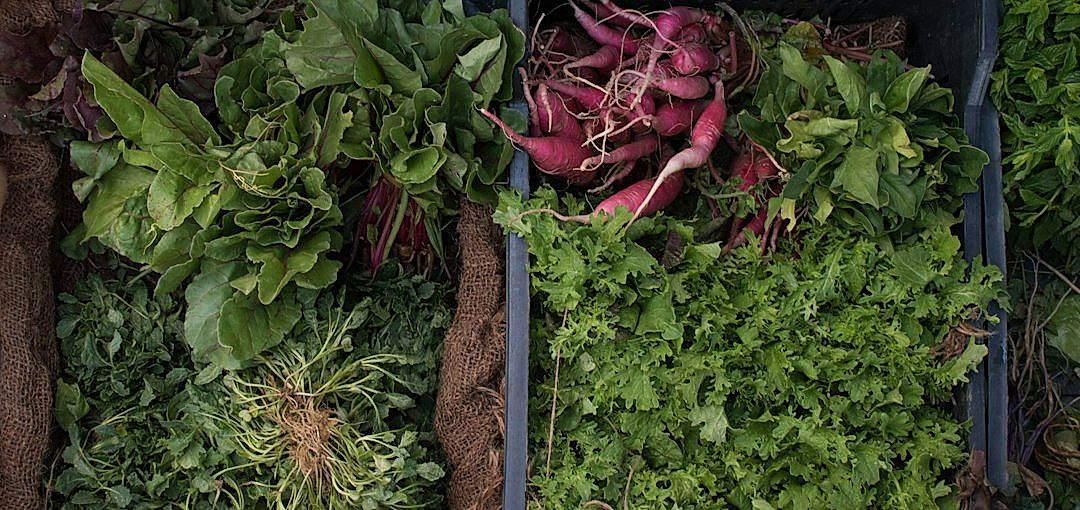The shift towards sustainable farming practices and consumption patterns is a trend with profound implications.
Local food movements are at the forefront of this change, reshaping the dynamics of the agriculture industry.
They represent a pivot from extensive, large-scale farming towards more localized, eco-friendly production methods.
This transformation undoubtedly affects many aspects of produce farming, causing both challenges and opportunities.
By delving into this emerging trend, this blog aims to shed light on its overarching effects and potential future trajectories.
It is essential to unravel the impacts and considerations, as they hold crucial ramifications on the sustainability and resilience of our food systems.
Contents
- Impacts Of Local Food Movements On Produce Farming
- 1. Increased income for small-scale farmers.
- 2. Improvement in Local Economies
- 3. Enhances Sustainability in Food Production
- 4. Farmers’ Market Expansions
- 5. Reduced Environmental Impact
- 6. Promotes Seasonal Eating Habits
- 7. Diversification of Produce Types.
- 8. Increased Local Job Creation
- 9. Fostering Community Cohesiveness
- 10. Revitalization of Rural Areas.
- The Bottom Line
Impacts Of Local Food Movements On Produce Farming
1. Increased income for small-scale farmers.
The rise of the local food movement has largely been seen as a positive change in the agricultural industry, especially for small-scale farmers.
With this shift towards locally-sourced produce, consumer demand for such produce has significantly increased.
Consequently, small-scale farmers who often struggled to compete with larger agriculture corporations, are finding more opportunities for financial stability and growth.
Quite simply, as more consumers buy local, small-scale farmers are able to sell more produce at a competitive price.
One of the key reasons behind this increased income is the shortened supply chain that accompanies local food systems.
Through selling directly to consumers or independent vendors, farmers are able to retain a greater share of the retail price of their produce.
The costs and complications associated with long-distance transportation and middlemen are largely eliminated.
This short supply chain also allows small-scale farmers to respond more quickly to market demands and shifts, further bolstering their income.
Moving away from mass production farming to more agile and responsive farming practices can be key for their economic survival.
Additionally, the direct connection between farmers and consumers fostered in local food systems can lead to greater loyalty and consistent demand.
Many consumers enjoy knowing where their food comes from and forming relationships with the people who grow it, adding a level of trust and personal connection that can translate into consistent sales for farmers.
Policies and initiatives that encourage local food movements also impact increased income for producers.
This can include grants, subsidies, or tax incentives for farmers who choose to sell their produce locally.
A number of municipalities and states across the globe have introduced such measures in recent years, recognising the economic and environmental benefits of embracing local food systems.
Of course, not every small-scale farmer will experience these benefits to the same degree.
Factors such as the type of produce grown, the location of the farm, the level of community engagement, and ongoing support from both the government and local consumers will greatly influence the potential for increased income.
2. Improvement in Local Economies
One of the most profound benefits of the local food movement on produce farming is the enhancement of local economies.
By prioritizing locally grown produce, communities are investing directly in their local economy.
Every dollar spent on locally grown food has a multiplier effect as it circulates within the community, boosting local economic activity.
The local food movement fosters a sense of fiscal responsibility amongst community members, as they recognize the direct impact their spending has in shaping their local economy.
Additionally, the local food movement helps to sustain small-scale farmers who might otherwise struggle to compete against larger, more industrially-focused farming operations.
When consumers choose to buy local, they are not just buying fresh and healthier produce; they’re also contributing to the livelihoods of local farmers and stimulating local economies.
Furthermore, local food movements have the potential to attract tourists who wish to engage in agrotourism, further adding to local economic activity.
Food festivals, farmers’ markets, and farm-to-table restaurants all provide unique opportunities for travelers to engage with local culture and cuisine, attracting tourism dollars to a community.
Moreover, local food movements can also stimulate innovation in agriculture within the community.
This includes the development and implementation of new farming methods, cropping patterns, and even the cultivation of new crop varieties, all of which can bring an increase in local economic activity.
In turn, this may lead to increased demand for local products, spurring economic growth even further.
Also, local food movements often place an emphasis on sustainable farming practices, which can decrease costs for farmers in the long run.
By encouraging practices such as organic farming and permaculture, farmers may be able to reduce their reliance on expensive synthetic fertilizers and pesticides, thereby reducing their costs and increasing their profit margin.
Overall, the advent of local food movements has the potential to bring about substantial economic benefits
From revitalizing local economies, supporting small-scale farmers, attracting tourism, driving innovation, and promoting sustainable practices, the impacts are broad and far-reaching.
3. Enhances Sustainability in Food Production
The growth of local food movements is increasingly resulting in enhanced sustainability in food production.
This is primarily achieved by adopting sustainable farming practices that minimize the impact on the environment and conserve natural resources.
Local food movements are encouraging farmers to avoid the use of harmful chemicals and pesticides that can harm the environment.
Through these movements, farmers learn about and implement organic farming techniques which rely on natural elements for pest control and enhancing soil fertility.
By fostering the use of organic fertilizers and natural pest control techniques, local food movements are helping further minimize the environmental impact of farming.
Furthermore, these sustainable farming methods help preserve biodiversity and the overall health of ecosystems.
They reduce the reliance on genetically modified crops and restore the natural balance of the environment by cultivating a variety of crops.
Another aspect of sustainability is the focus on seasonal and local produce which significantly reduces the need for long-distance transportation.
This not only leads to reduction in carbon footprint and energy consumption but also ensures the freshness and quality of the produce.
The food produced by these practices is more nutritious as it is free from harmful chemicals and is consumed when it’s fresh and at its peak nutritional value.
Additionally, the promotion of small-scale farming by local food movements empowers local farmers and reduces the power of large agribusinesses.
This is inherently more sustainable as it creates a more balanced food system where the wealth and resources are more equitably distributed.
Moreover, local food movements help smaller farms to remain in business and tackle the competition posed by larger farms.
Finally, the focus on selling produce directly to the consumers at farmers’ markets and other local outlets reduces the number of intermediaries and ensures a fair price for the farmers.
Therefore, the local food movement not only enhances economic sustainability for farmers but also promotes environmental sustainability in food production.
4. Farmers’ Market Expansions
An integral part of local food movements is the expansion of farmers’ markets.
These mark a significant shift from the traditional supermarket-centred food acquisition routine to a more community-centric and locally supportive scheme.
They often consist of local farmers and producers selling their goods directly to consumers.
These markets tend to favour small-scale farming operations, giving these businesses an outlet to sell their produce.
As a result, the financial viability of small farming businesses improves and contributes to the sustainable growth of rural economies.
The expansion of farmers’ markets inherently helps in the reinvigoration of local communities, and can lead to a strengthened relationship and sense of trust between producers and consumers.
In today’s world where consumer awareness about food sources is increasing, these markets have gained significant popularity.
Many consumers prefer knowing where their food comes from and who grows it, these markets are a direct line to that knowledge.
With the rising concerns over climate change, supporting local food sources also becomes a means to reduce the carbon footprint associated with long-distance transportation of food.
Farmers’ markets present a platform for diversity in produce as well.
Local farmers, with the assurance of sales, are more likely to grow a variety of crops rather than focusing on just one or two commodity crops.
This not only contributes to an increase in the local biodiversity, but also promotes healthy diets and lifestyles within the local community.
Given these factors, it’s clear that the expansion of farmers’ markets as a part of the local food movement impacts produce farming in a number of positive ways.
From boosting local economies and reducing environmental impacts to promoting sustainability and community engagement, the benefits are extensive and multi-faceted.
While challenges may persist in expanding these markets, their impact on local farming and their value to the community cannot be underestimated.
Therefore, supporting and promoting these markets should be a critical consideration for anyone interested in advancing local food movements and improving the sustainability and resilience of local farming operations.
5. Reduced Environmental Impact
Understanding the environmental impact of food production is crucial in assessing the implications of local food movements on produce farming.
Traditionally, food transportation has caused significant carbon emissions, leading to negative impacts on the environment.
However, the local food movement helps to mitigate these effects by reducing the distance food travels before it reaches consumers.
Buying locally grown produce can significantly reduce the carbon footprint associated with food transportation.
Local farms generally use more sustainable farming methods that are respectful to the land and the surrounding environment.
The majority of the local farmers refrain from using harmful pesticides and chemicals, reducing water and soil pollution.
Additionally, they typically cultivate a variety of crops, which can benefit local ecosystems by promoting biodiversity.
This reduces the risk of disease and pest outbreaks that can occur in monoculture plantations, further decreasing dependence on harmful chemicals.
Local food movements also encourage composting and waste reduction, which contribute positively to the environment.
Often, these farms use compost generated from organic food waste as a natural fertilizer, which enriches the soil and reduces the need for chemical inputs.
Moreover, buying locally grown food can potentially lead to reduced packaging and plastic waste, since there is less need for long-term storage and transportation.
When people consume food produced within their local areas, they’re not only eating fresher, but they’re also contributing to a more sustainable food system that respects the earth.
By supporting local farming, consumers can help protect the environment, enhance biodiversity, reduce waste, and combat climate change.
In essence, the local food movement’s emphasis on sustainability can contribute to a reduced environmental impact in the long run.
Due to the above reasons, it’s reasonable to conclude that the local food movement’s impact on the environment revolves around reducing environmental degradation and promoting sustainable practices.
In turn, these benefits of the local food movement can influence consumer choices and drive further support for local produce farming, thereby, promoting a sustainable and eco-friendly food system.
6. Promotes Seasonal Eating Habits
The local food movement plays a significant role in influencing consumer behavior and shaping dietary habits, most notably promoting the consumption of seasonal products.
Unlike traditional retail outlets that usually stock up on a variety of fruits and vegetables irrespective of the season, local farmers’ markets are distinct in their emphasis on seasonal produce.
They mark the change in seasons with a change in the options of fruits and vegetables available, encouraging consumers to adapt their diet according to the time of year.
This not only promotes healthier eating habits as seasonal fruits and vegetables tend to be fresher and more nutritious, but it also supports biodiversity by varying the types of produce grown each season.
From spring peas to summer berries, fall apples to winter squashes, local food movements help consumers discover a variety of fresh produce specific to each season.
This shift in dietary habits reflects a broader societal movement towards a more sustainable and mindful way of living, with individuals being more aware of where their food comes from, how it is produced, and the impact of their consumption habits on the environment and local economy.
By promoting seasonal eating habits, local food movements ensure that the produce is consumed when it is at its freshest, thus guaranteeing optimum taste and nutritional content.
Critics might argue that it limits one’s dietary choices, yet a counter-argument is that it introduces consumers to a wider array of produce that they might otherwise overlook from a standard supermarket aisle.
Moreover, the notion of eating seasonally compels the inclusion of a diverse range of produce in our diet, ensuring a mix of different nutrients essential for overall health.
Consuming produce in its peak season also diminishes the need for artificial ripening, preservatives, and lengthy storage, contributing to lower environmental impact.
This way, local food movements can aid in decreasing the demand for out-of-season produce, which typically involves unenvironmentally friendly practices like long-distance shipping and energy-intensive greenhouse farming.
Additionally, it may even encourage local gastronomy and foster community connections as people collectively anticipate, celebrate, and enjoy the bounty of each season.
This renewed emphasis on seasonal eating, nourished by our local landscapes, goes beyond merely satisfying one’s hunger—it contributes to the establishment of a balanced, sustainable food system that promotes biodiversity and environmental stewardship.
Undeniably, supporting local food movements and embracing the concept of seasonal eating marks a significant step towards our shared goal of building resilient, healthy, and sustainable communities.
It is an action that is as good for the planet as it is for our health, palate, and local economies.
7. Diversification of Produce Types.
The impact of local food movements on farming practices is manifold, a significant aspect being the promotion of diversification of produce types.
This trend essentially encourages farmers to shift from mono-culture or single-crop farming to the cultivation of a greater assortment of fresh produce.
Inherent demand for varied, flavorful, and niche crops emerging out of farm-to-fork initiatives fuels this agricultural diversity.
A diversified production not only contributes to the farmer’s income but also enhances food security in the community.
Diversification acts as an insurance against the failure of one crop type, ensuring reliable, regular harvests and a diversity of nutrients available to consumers.
This shift also strengthens the resilience of the farm ecosystem as diversity helps in battling pests and diseases, decreasing dependency on chemical inputs.
The local food movements’ push for diverse crops has, in many cases, revived the cultivation of heirloom and indigenous varieties of crops, which are often known for their superior taste and nutritional content as well as their resilience to local pests and climate patterns.
Such revivals preserve the genetic diversity in our food system, a key factor in ensuring food security in the long run.
Biodiversity on farms serves as a buffer against environmental changes, ensuring sustained production despite climate fluctuations.
Furthermore, it facilitates more efficient utilization of resources, as different plants have different growth habits and nutritional needs, enabling them to coexist symbiotically.
Meanwhile, diversified farming operations often involve rotation and intercropping, practices that improve soil fertility and overall ecosystem health.
From a market perspective, diversified farms can offer a wider array of products to their customers, meeting the consumers’ growing demands for fresh and exotic produce.
Additionally, this can lead to higher sales and improved financial stability for small-scale farmers.
It also contributes to the esthetic appeal of farm landscapes, attracting more community members and tourists, thereby promoting agritourism.
In this sense, the diversification pushed by the local food movement is not only beneficial to farmers and consumers, but it revitalizes local economies and strengthens communities.
8. Increased Local Job Creation
One of the most significant impacts of the local food movement on produce farming is the increase in local job creation.
Decentralized food production systems, like those promoted by local food movements, are labor-intensive and hence, necessitate a substantial workforce.
This leads to the creation of new jobs in farming, retail, and distribution sectors linked with local food production.
The jobs created are often varied and include positions for farm workers, truck drivers, grocery store clerks, and farmers market coordinators, among others.
Moreover, these jobs are generally stable and locally-based, contributing to poverty reduction and better economic conditions in the community.
Additionally, local job creation also means that community members have the opportunity to work closer to home, reducing commutes and allowing families to stay together.
This, in turn, helps to create a sense of community pride and identity, further reinforcing the overall positive impact of local food movements.
Furthermore, as the demand increases for locally grown produce, new markets and opportunities for entrepreneurship also open up.
For instance, farmers can start their local delivery services, start a canning business to preserve the season’s surplus produce or develop a farm-to-table restaurant.
Such new business ventures can diversify the local economy and make it more resilient.
Beyond direct job creation, local food movements can indirectly create jobs in other areas such as agri-tourism and agricultural education.
Tourism connected to local foods, such as farm visits, wine tastings, and cooking classes, can boost the local leisure and hospitality sector.
Similarly, increased interest in local foods can spur education initiatives, like gardening classes and agriculture courses, providing potential employment in the education sector.
Importantly, locally sourced food initiatives also have the potential to create green jobs within the agricultural sector by encouraging sustainable farming practices.
This aligns with global efforts to combat climate change and promote environmental sustainability.
Ultimately, the creation of local jobs through local food movements is an essential step in building stronger, more resilient communities and economies.
9. Fostering Community Cohesiveness
There is a significant and often overlooked impact of local food movements and produce farming on social facets of community life.
One of the profound impacts is in fostering community cohesiveness.
Promoting local food and produce farming gives community members a sense of identity and pride.
When people consume locally produced food, they are not merely ingesting nutrients, but also absorbing a piece of their local culture and tradition.
This contributes to bringing community members together, strengthening communal bonds.
Local food movements become a binding force, uniting individuals while nourishing them.
People are more open and collaborative in supporting local produce farmers, an act that promotes a broader sense of community cohesiveness.
Community farmers’ markets, for instance, serve as a place where community members interact, communicate, and strengthen their bonds.
They are not just places where transactions occur; they are also places where local culture is shared and celebrated.
Local food movements introduce community members to the people who work the land and produce their food.
By doing so, it makes them an integral part of a shared local food system, enhancing a sense of belonging and community togetherness.
Moreover, local food movements often go hand-in-hand with other communal initiatives, such as education programs, food festivals, or community gardening projects.
These efforts offer additional opportunities for community members to engage, collaborate, and deepen their communal ties.
Supporting local produce farming is also a way for community members to contribute to their community’s wellbeing and sustainability.
In doing so, they are taking part in an endeavor much larger than themselves.
By purchasing locally produced food, community members participate in making their community more resilient, prosperous, and cohesive.
In short, fostering community cohesiveness is a profound, multi-faceted impact of local food movements and produce farming that extends far beyond the realm of food production and consumption.
10. Revitalization of Rural Areas.
The local food movement has a pronounced effect on the revitalization of rural areas.
When consumers prioritize buying from local producers, this does two major things: it circulates money within the community and incentivizes local farming.
In the process, communities can transform economically challenged rural areas into bustling centers of agri-business activity.
The encouragement and expansion of local agrarian initiatives can lead to an increased number of farming operations which injects new life into rural regions.
Also, the rise in the agricultural operation in these areas often necessitates the improvement and development of local infrastructure.
Things like roads, electricity, and even internet services improve, thus making these regions more hospitable and attractive to both residents and visitors.
This local infrastructure improvement has a direct positive impact on the rural economy and the quality of life for its residents.
This is because these developments not only facilitate the local farming operations but also indirectly stimulate other forms of trade and commerce.
Similarly, the increased farming activity often leads to the creation of value-added agricultural businesses such as local breweries, cheese makers, and bakeries, which diversify the local economy and add to its resilience.
More than just economics, the local food movement helps to foster a sense of community and gives residents a new awareness and appreciation for the land.
People become more familiar with the food they consume and where it comes from, and this often nurtures a sense of pride and stewardship for the local environment.
More people are drawn to spend time in rural areas, either to visit the farms, attend farmers markets, or even to take up new farming ventures themselves.
This influx of activity and interest can lead to a renaissance of the rural culture, with new festivals, traditions, and local pride growing out of the community’s newfound passion for local produce.
It’s essential to note that while this process of revitalization may not happen overnight, the continual support of local food initiatives can set the foundation for long-term, sustainable rural development.
However, this revitalization will not occur without support from governments, organizations, and the public to maintain and encourage the local food movement.
By understanding and advocating for the critical role local farming plays in the revitalization of rural areas, we can help ensure that these communities have not just access to quality, locally sourced food, but also the economic stimulus, enhanced infrastructure, and invigorated community spirit that accompanies successful local food initiatives.
The Bottom Line
Supporting local agriculture, particularly through farmer’s markets, has numerous immediate and long-lasting benefits.
Most prominently, local farming directly boosts the income of small-scale farmers and drives local economies forward.
It encourages environmental care and paves the way for enduring food production practices.
This, alongside market expansions and the creation of more local jobs, ensures a more diversified and robust agricultural sector.
More than economic gains, buying local fosters a sense of community unity and promotes healthier, season-bound eating habits.
Ultimately, this revitalizes not just rural areas, but the agricultural sector and the community as a whole, emphasizing that supporting local agriculture is a sustainable investment which holds benefits that extend far beyond the farm gate.




